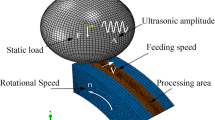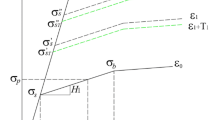Abstract
To achieve high machining efficiency in optimal surface integrity manufacturing, a relationship model between rolling depth and rolling force was established based on Hertz contact theory, and a theoretical model of impact characteristics was established according to the indentation geometry to evaluate the machining efficiency. Subsequently, the plane ultrasonic rolling experiment of 7075 aluminum alloy was carried out to verify the relationship between rolling depth and rolling force; meanwhile, the mapping between process parameters and surface characteristics, impact characteristics, and surface morphology were studied, respectively. On this basis, the surface integrity prediction model was established by using nonlinear curve fitting method, and the optimal parameter solution was obtained by using quantum genetic algorithm (NSGA-II). The results show that the rolling force increases linearly with the increase in rolling depth. The impact characteristics increase with the increase in static force and amplitude, and decreases with the increase in step and feed speed, and the impact characteristics is negatively correlated with the processing efficiency. The optimization results provide a reference for engineering applications.










Similar content being viewed by others
Data availability
The datasets used or analyzed during the current study are available from the corresponding author on reasonable request.
References
Liu H, Zheng J, Guo Y, Zhu L (2020) Residual stresses in high-speed two-dimensional ultrasonic rolling 7050 aluminum alloy with thermal-mechanical coupling [J]. Int J Mech Sci 186:105824. https://doi.org/10.1016/j.ijmecsci.2020.105824
Zhuang W, Liu Q, Djugum R, Sharp PK, Paradowska A (2014) Deep surface rolling for fatigue life enhancement of laser clad aircraft aluminum alloy [J]. App Surf Sci 320:558–562. https://doi.org/10.1016/j.apsusc.2014.09.139
Zulan R (2016) Experimental Study on high-cycle fatigue life enhancement of shot-peening Al alloy [J]. Hot Work Technol 4:134–136. https://doi.org/10.14158/j.cnki.1001-3814.2016.04.041
BHWA, AGS, BGTA (2015) Enhanced surface properties of austenitic stainless steel by electro pulsing-assisted ultrasonic surface rolling process [J]. Surf Coatings Technol 282(51):149–154. https://doi.org/10.1016/j.surfcoat.2015.10.026.
Jiao F, Lan SL, Wang Y, Zhao B (2020) Residual stress characteristics and parameters optimization of ultrasonic rolling 12Cr2Ni4A gear steel [J]. Surf Technol 49(21):334–341. https://doi.org/10.16490/j.cnki.issn.1001-3660.2020.11.039
Dai K, Shaw LK (2007) Comparison between shot peening and surface nano crystallization and hardening processes [J]. Mat Sci Eng 463(1–2):46–53. https://doi.org/10.1016/j.msea.2006.07.159
Sun YS, Jia YF, Yuan GJ, Li X, Zhang XC (2021) Inversion and finite element analysis of mechanical properties of pure titanium gradient material by ultrasonic surface rolling processing [J]. Mat Mech Eng 45(10):58–65. https://doi.org/10.11973/jxgccl202110008
Chen LQ, Xiang B, Ren XC, Liu XG, Lin GB (2014) Influence of surface ultrasonic rolling process parameters on surface condition of axle steel sued on high speed train [J]. China Surf Eng 27(5):1–7. https://doi.org/10.3969/j.issn.1007-9289.2014.05.012
Zhu YL, Li L, Wang K, Huang YL (2009) An integrated ultrasonic deep rolling and burnishing technology for anti-fatigue manufacturing. J Mech Eng 45(9):184–186. https://doi.org/10.3901/JME.2009.09.183
Bozdana AT, Gindy NZ (2008) Comparative experimental study on effects of conventional and ultrasonic deep cold rolling processes on Ti-6Al-4V. Mater Sci Technol 24(11):1378–1384. https://doi.org/10.1179/174328408X302431
Wang P, Pan Y, Liu Y, Fu X, Li H (2021) Research on surface properties of Ti-6Al-4V alloy by multi-ultrasonic rolling [J]. Arc Proceed Institut Mech Eng Part C J Mech Eng Sci 1908:1258-1263. https://doi.org/10.1177/0954406220984194
Liu Y, Fu X, Li H, Wang P, Men X (2021) Experimental and simulation requirements for residual stress of TC4 titanium alloy based on ultrasonic rolling [J]. IOP Conf Ser: Mat Sci Eng 1063(1):012001. https://doi.org/10.1088/1757-899X/1063/1/012001
Zhao Y C, Zhang F (2017) Effect of static pressure on surface characteristics of ultrasonic rolling. Surf Technol 46(5):152-158. CNKI: SUN:BMJS.0.2017-05-026
Liu C, Liu D, Zhang X, Yu S, Zhao W (2017) Effect of the ultrasonic surface rolling process on the fretting fatigue behavior of Ti-6Al-4V Alloy [J]. Materials 10(7):833. https://doi.org/10.3390/ma10070833
Dan L, Liu D, Zhang X, Liu C, Ni A (2018) Surface nanocrystallization of 17–4 precipitation-hardening stainless steel subjected to ultrasonic surface rolling process [J]. Mater Sci Eng, A 726:69–81. https://doi.org/10.1016/j.msea.2018.04.033
Zheng JX, Jiang SX (2017) Residual stress field in the process of 2D ultrasonic rolling 7050 aluminum alloy. Surf Technol 46(12):265–269. https://doi.org/10.16490/j.cnki.issn.1001-3660.2017.12.041
Ye H, Lai LS, Li J et al (2018) Surface properties of 7075 Aluminum alloy workpieces after ultrasonic burnishing processing. Surf Technol 47(2):8–13. https://doi.org/10.16490/j.cnki.issn.1001-3660.2018.02.002
Zhao J, Wang B, Liu ZQ (2016) The investigation into burnishing force, burnishing depth and surface morphology in rotary ultrasonic burnishing. Acta Armamentarium 37(4):696–704. https://doi.org/10.3969/j.issn.1000-1093.2016.04.018
Huang SQ, Chao GB, Peng M et al (1990) Experimental calculating the surface roughness of SUS304 steel produced by the vibratory ball burnishing process. J Chengdu Univ Sci Tech 51(3):1–8
Zhao YC, Wen CB (2017) Simulation of 3D residual stress field of ultrasonic surface rolling by dynamic finite element analysis. J Mech Stren.gth 39(4):875-881. CNKI:SUN:JXQD.0.2017-04-023
Johnson KL (1985) Contact mechanics [M]. The University of Cambridge, England. https://doi.org/10.1017/S0003598X00025989
Xu HY, Huang YY, Cui FK (2018) A model for surface residual stress of ultrasonic rolling extrusion bearing ring. J Plast Eng 25(05):205–211. https://doi.org/10.3969/j.issn.1007-2012.2018.05.029
Funding
This research was supported by the Key R&D and Promotion Program (Science and Technology) in Henan Province, China (No. 222102220003).
Author information
Authors and Affiliations
Contributions
Shuai-ling Lan: writing original draft, editing, and experimental research. Meng Qi: conceptualization and review. Ming-xian Liu: experimental research. Wen-bo Bie: supervision.
Corresponding author
Ethics declarations
Ethical approval
The authors state that this paper is an original work, it has not been published in any journals, and this research does not involve any ethical issues of humans or animals.
Consent to participate
The authors declare that this research involves no human participants and/or animals.
Consent to publication
The authors confirm that the paper described has not been published before; that it is not under consideration for publication elsewhere; that its publication has been approved by all co-authors; that its publication has been approved by the responsible authorities at the institution where the work is carried out. The authors agree to publication in the journal indicated below and also to publication of the article in English by Springer in Springer’s corresponding English-language journal. The copyright to the English-language article is transferred to Springer effective if and when the article is accepted for publication. The author warrants that his/her contribution is original and that he/she has full power to make this grant. The author signs for and accepts responsibility for releasing this material on behalf of any and all co-authors. The copyright transfer covers the exclusive right to reproduce and distribute the article, including reprints, translations, photographic reproductions, microform, electronic form (offline, online), or any other reproductions of similar nature.
Conflicts of interest
The authors declare no competing interests.
Additional information
Publisher's note
Springer Nature remains neutral with regard to jurisdictional claims in published maps and institutional affiliations.
Rights and permissions
Springer Nature or its licensor (e.g. a society or other partner) holds exclusive rights to this article under a publishing agreement with the author(s) or other rightsholder(s); author self-archiving of the accepted manuscript version of this article is solely governed by the terms of such publishing agreement and applicable law.
About this article
Cite this article
Lan, Sl., Qi, M., Liu, Mx. et al. Theoretical calculation and experiment of the impact characteristics in the plane ultrasonic rolling. Int J Adv Manuf Technol 124, 2675–2684 (2023). https://doi.org/10.1007/s00170-022-10439-1
Received:
Accepted:
Published:
Issue Date:
DOI: https://doi.org/10.1007/s00170-022-10439-1




